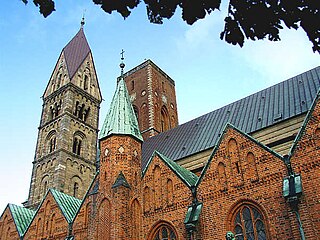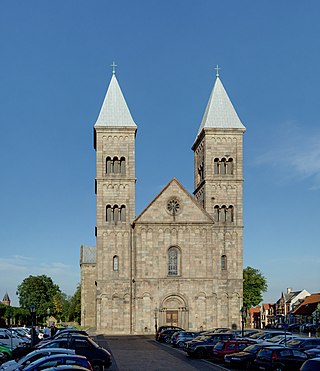
Christian III reigned as King of Denmark from 1534 and King of Norway from 1537 until his death in 1559. During his reign, Christian formed close ties between the church and the crown. He established Lutheranism as the state religion within his realms as part of the Protestant Reformation, and was the first King of Denmark-Norway.

The Count's Feud, also called the Count's War, was a war of succession that raged in Denmark in 1534–36 and brought about the Reformation in Denmark. In the international context, it was part of the European wars of religion. The Count's Feud takes its name from the Protestant Count Christopher of Oldenburg, who supported the Catholic King Christian II, deposed in 1523, over the election of Christian III, a staunch Protestant who had already implemented Lutheranism as the state religion in Schleswig and Holstein in 1528.

Aarhus Cathedral is a cathedral in Aarhus, Denmark. It is the longest and tallest church in the country, at 93 m (305 ft) in length and 96 m (315 ft) in height.

The former Diocese of Aarhus was a Roman Catholic diocese in Denmark, founded in the 10th century and dissolved during the Protestant Reformation. The diocese included the counties of Aarhus and Randers, the islands of Samsø and Tunø, and, after 1396, part of the county of Viborg.

The former Diocese of Børglum was a Roman Catholic diocese in Northern Jutland, Denmark. It has also been referred to as the Diocese of Vestervig or the Bishopric of Vendsyssel. The diocese included Vendsyssel, Hanherred, Thy, and Mors.

The former Diocese of Odense was a Roman Catholic diocese in Denmark which included the islands of Funen, Langeland, Tåsinge, Lolland, Falster, Als, and Ærø. Its episcopal see was located in Odense at St. Canute's Cathedral.

The former Diocese of Ribe was a Roman Catholic diocese in Southern Jutland, Denmark. The diocese was established in 948, and dissolved in 1536 during the Protestant Reformation. Within the newly established protestant Church of Denmark, the Diocese of Ribe effectively replaced its Roman Catholic precursor.

The Diocese of Aarhus is one of 10 dioceses in the Church of Denmark, with headquarters in the city of Aarhus. The diocese covers a large district of northeast Jutland and comprises 14 deaneries, of which four cover the extent of Aarhus city itself.

The election of Christian III as king of Denmark on 4 July 1534 was a landmark event for all of Denmark and also Norway. It took place in St. Søren's Church in the town of Rye in eastern Jutland, where the Jutlandic nobility elected Prince Christian, son of King Frederick I and Duke of Schleswig and Holsten, as king. This brought about the Count's Feud and later also led to the implementation of the Protestant Reformation in Denmark and Norway.

The Reformation in Denmark–Norway and Holstein saw the transition from Catholicism to Lutheranism in the realms ruled by the Danish-based House of Oldenburg in the first half of the sixteenth century. After the break-up of the Kalmar Union in 1521/1523, these realms included the kingdoms of Denmark and Norway and the Duchies of Schleswig and Holstein, whereby Denmark also extended over today's Gotland and Øsel in Estonia.

The former Diocese of Viborg was a Roman Catholic diocese in Denmark. It was established in 1065 and was dissolved in 1536 during the Protestant Reformation.
Stygge Krumpen was a Danish clergyman and bureaucrat, who was the secretary of king Christian II of Denmark and the last Catholic bishop of the Diocese of Børglum from 1533 to 1536, having been coadjutor bishop since 1519. He was the brother of Danish Marshal Otte Krumpen. With them, the Krumpen family died out.
The Diocese of Zealand was a Protestant diocese in Denmark that existed from 1537 to 1922. The diocese had been formed in 1537 following the Reformation of Denmark, and was dissolved in 1922 when it was divided into the Diocese of Copenhagen and the Diocese of Roskilde. While it existed, the diocese functioned as the head of the Church of Denmark, beneath the crown, and its bishop was regarded as Primus inter pares.
Events from the 1530s in Denmark.
Events from the 1550s in Denmark.
Events from the 1480s in Denmark.

Hoskuld Hoskuldsson was the 28th and last Roman Catholic Bishop of Stavanger, from 1513 until the Reformation in 1537, and also a member of the Riksråd.
Olav Torkelsson, also known as Olaf Thorkelsön, was the 31st and last Roman Catholic Bishop of Bergen, from 1523 to 1535, and a member of the Riksråd.

Peder Jensen Lodehat was the bishop of the Diocese of Aarhus and a significant political figure in Denmark during the reign of Queen Margrete I. Lodehat was originally from a minor noble family in Zealand but made a career in the Catholic Church as bishop of a total of 3 dioceses. He served on the Danish Riksråd and had a role in getting Margrethe I appointed queen. Lodehat also had a central role in the creation of the Kalmar Union and may have authored the founding documents. The surname Lodehat stems from a type of hat, Lodehat, featured on the family coat of arms but although the family has become known under this name they likely didn't use it in their own time.










